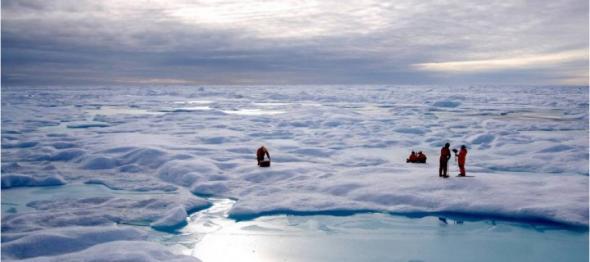Ice has been a relatively constant feature of the Arctic for most of the past 36 million years, but there have been some gaps. Scientists aren’t exactly sure what happened during the most recent major ice-free period, but it’s often considered an analog to our future, warmer Earth. The only difference is, the gap in Arctic sea ice that scientists believe will happen by midcentury is being caused by us.*
Scientists are now piecing together the puzzle in an increasingly urgent attempt to understand what might happen once Arctic ice goes away again, effectively for good. One new study, published last week in the journal Nature Communications, attempts determine what happened during that last major gap in Arctic ice.
The study provides new evidence that the last major gap ended about 2.6 million years ago, after which ice sheets spread southward and humanity’s ancestors began to respond to colder temperatures in Africa, forcing adaptation like the use of stone tools. Humans themselves wouldn’t evolve for more than a million more years.
The study cites geological changes in the Arctic region, like mountainous uplifts and the connection of North and South America in present-day Panama, as mostly responsible for the burst of ancient ice. Those changes altered ocean dynamics and sharply increased the availability of freshwater in the Arctic, which freezes more easily than salty water.
To come to this conclusion, the researchers used a proxy for the presence of sea ice—a “mono-unsaturated highly branched isoprenoid lipid” that’s produced by single-celled sea plants and deposited in ancient sediment at the bottom of the ocean. The sediment core sample they obtained spans more than 4 million years—a complete chronicle of the entire ancient ice-free period. The samples were taken from the Fram Strait, off the east coast of Greenland.
Here’s the rough timeline they came up with (with some additional dates for perspective):
5.3 million years ago, there were dense spruce and pine forests in the far northern Arctic. Greenland had 30 percent less ice than today, and global seas were about 60 feet higher.
4 million years ago, there was about as much ice in the winter as currently exists in the summer, and summers were probably ice-free. This is an analog for what we may experience in the near future; estimates suggest global temperatures could rise four degrees Celsius higher than today in the next 85 years, about as hot as temperatures were back then.
2.6 million years ago, geologic uplift forced the closure of Arctic Ocean gateways, like the Bering Strait, and thermally isolated the region. That restricted the Arctic’s circulation, causing a build-up of fresh water and conditions favorable for major ice sheets to form. From that point, there was runaway cooling as ice sheets grew as far south as present-day St. Louis and New York City. The most current cycle of ice ages began, and human ancestors were forced to adapt. This started the transition that would result in homo sapiens.
200,000 years ago, modern humans emerged.
12,000 years ago, the most recent ice age ended, setting the stage for the beginning of human civilization.
250 years ago, coal was first used to power steam engines in England.
1 year ago, atmospheric carbon dioxide reaches 400 parts per million for the first time in at least 800,000 years, probably longer.
It took 100,000 generations for human ancestors to transition to something resembling us. For each of those 100,000 generations, the planet was crowned with ice. Now, that ice will probably go away. That incredibly rapid rate of change—10 times faster than any change recorded over the past 65 million years—is extinction-worthy.
The research will help improve models of a melting Arctic, so we can better understand the implications for those of us that’ll have to deal with them. Our ancestors didn’t see their version of climate change coming. Our descendants will.
*Correction, Dec. 2, 2014: This post originally misstated that the Arctic is facing a gap in sea ice. This gap is expected by scientists to occur by midcentury, but is not occurring now.
